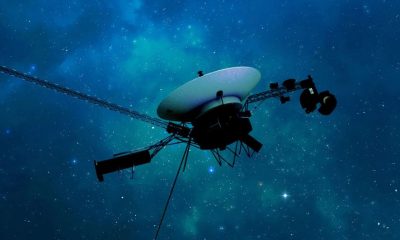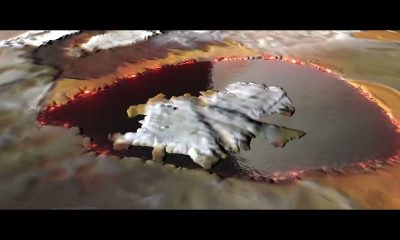News
Discovering Insights While Flying Through the Plumes of Enceladus

In the next decade, space agencies will expand the search for extraterrestrial life beyond Mars, where all of our astrobiology efforts are currently focused. This includes the ESA’s JUpiter ICy moon’s Explorer (JUICE) and NASA’s Europa Clipper, which will fly past Europa and Ganymede repeatedly to study their surfaces and interiors. There’s also NASA’s proposed Dragonfly mission that will fly to Titan and study its atmosphere, methane lakes, and the rich organic chemistry happening on its surface. But perhaps the most compelling destination is Enceladus and the lovely plumes emanating from its southern polar region.
Since the Cassini mission got a close-up look at these plumes, scientists have been aching to send a robotic mission there to sample them – which appear to have all the ingredients for life in them. This is not as easy as it sounds, and there’s no indication flying through plumes will yield intact samples. In a recent paper, researchers from the University of Kent examined how the velocity of a passing spacecraft (and the resulting shock of impact) could significantly affect its ability to sample water and ice within the plumes.
The research was conducted by Prof. Mark Burchell and Dr. Penny Wozniakiewicz (an Emeritus Professor and a Senior Lecturer in Space Science) from the Centre for Astrophysics and Planetary Science (CAPS), part of the School of Physics and Astronomy at the University of Kent, UK. Their work could have significant implications for missions to Icy Ocean Worlds (IOW), bodies in the outer Solar System composed predominantly of frozen water and volatiles with oceans in their interior. These bodies have become of increasing interest to scientists since it is possible some could support life.
The term “Ocean Worlds” has become common in recent years as the number of potential candidates for exploration has increased. Since the Voyager probes passed through the system in 1979, scientists have speculated about the possibility of an interior ocean within Europa based on its surface features. This included patches of “young terrain” sitting next to older, cratered terrain – indicative of regular exchanges between the surface and interior. The Voyager probes noticed similarly youthful terrain on Enceladus when they few past Saturn in 1980 and 81 (respectively).
However, it was the Cassini-Huygens mission that discovered water vapor and organic molecules venting from the Enceladus’ southern polar region in 2004. Over the next thirteen years, the Cassini orbiter conducted several more flybys of the moon, yielding additional evidence of an interior ocean and an energy source at the core-mantle boundary. These findings placed Enceladus among the “Ocean Worlds” that scientists want to examine more closely with future missions. But unlike other IOWs, Enceladus is particularly attractive because of the nature of the plumes around its south pole.
Whereas Europa also experiences plume activity, these are more sporadic and difficult to detect. Due to Europa’s higher gravity (~13% vs. 1% of Earth’s), water vapor and vented material don’t reach nearly as far into space. As Burchell told Universe Today via email, collecting samples from these plumes seems relatively simple, at least in theory. “Like all IOWs, it has an internal ocean with lots of water. What is in that water is the subject of much speculation and interest,” he said. “And Enceladus ejects plumes of water into space, making any space mission that wants to sample the water much easier – you can just fly through the plume.”
However, in the realm of practice (as always), things get a little more complicated. Depending on how fast a mission is traveling, the impact it will inflict upon plume material will vary considerably. As Burchell explains, this could jeopardize the very samples a mission was trying to obtain:
“The problem with collecting samples at speed is that a lot of testing has been done with metal and mineral projectile, but less is known about the response of organics to the high-speed impacts. The bonds in the organics will break, but at what speed? And which bonds first? So what you end up with for analysis may not be what came out of Enceladus. But with what biases? What degree of alteration? Understanding this is essential to any successful collection of samples.”

According to Burchell, modeling how a spacecraft’s velocity would affect its ability to collect samples can be accomplished in one of two ways. On the one hand, there’s the computer modeling approach, where teams rely on advanced software to simulate impacts and measure the results. The other is the “kinetic” approach, which consists of firing small grains at targets at the right speeds and then measuring the force of impact. Burchell and his team prefer to do the latter. “In our lab, we like firing things at targets,” he said.
Their results clearly showed that the collection speed is critical to sample collection. However, they also found that the results vary from one body to the next. Said Burchell:
“In an orbit at a small body like Enceladus, it is fairly low. But for the larger IOWs, it is greater. And it just gets into the regime where the shock of the impact process in the collection causes increasingly severe alteration to the samples. If you do a flypast of the IOW without orbiting it, you are faster again, and the samples experience a greater shock. It suggests a low-speed orbital collection is best for un-shocked, minimally processed samples. But that needs more spacecraft design and restricts the other science you could do. It is always a tradeoff.”
Without the Solar System, there are several bodies where water and other volatiles are vented from the interior – a phenomenon known as cryovolcanism. These bodies vary considerably in terms of their size and gravitational pull, ranging from the microgravity (less or slightly more than 1%) of Mimas and Enceladus to the roughly 13-15% of Europa, Titan, and Ganymede. As a result, these findings could help inform the design of many sample-collection missions destined for IOWs.
Further Reading: Meteoritics & Planetary Science
News
University of Wisconsin-Milwaukee and Protesters reach an agreement to dismantle encampment

Protesters at the University of Wisconsin-Milwaukee have agreed to end their pro-Palestinian encampment following an agreement reached with the school, university officials announced on Sunday. The encampment, which had been in place for two weeks, will be dismantled by Tuesday, marking the end of what was believed to be the last standing encampment at a Wisconsin college.
University officials had allowed the encampment to remain on a patch of lawn between Mitchell Hall and a busy thoroughfare on the campus’s southern boundary, opting not to involve law enforcement. This approach differed from the response at the University of Wisconsin-Madison, where police were called in to remove tents after negotiations fell through. Despite initial efforts to disband the encampment, Wisconsin-Madison eventually reached an agreement with protesters to voluntarily dismantle the camp prior to commencement ceremonies.
Chancellor Mark Mone of Wisconsin-Milwaukee stated last Wednesday that the university had exhibited “the widest possible amount of patience and restraint.” However, he also cautioned that patience was wearing thin and hinted at potential action by the school. Following discussions with the UWM Popular University for Palestine Coalition, the university agreed to advocate for a cease-fire between Israel and Hamas, condemn the destruction of schools and universities in Gaza by Israeli forces, and hold meetings with protest leaders regarding university investments.
Additionally, the university pledged to urge the Water Council, a Milwaukee organization of water technology companies, to sever connections with two Israeli government-owned entities, Mekorot and the Israel Innovation Authority. Chancellor Mone serves as the treasurer on the Water Council’s board of directors.
In return for these commitments, the protesters agreed to dismantle the encampment beginning on Sunday and completing the process by Tuesday. They also agreed not to disrupt the university’s commencement ceremonies scheduled for Sunday. In a statement, the protesters expressed their satisfaction with the agreement, stating, “After hard fought edits and careful consideration by the coalition, we determined we had obtained all possible benefits from the encampment.”
The resolution of the encampment at the University of Wisconsin-Milwaukee represents a successful outcome of negotiations between university officials and protesters. By reaching a compromise that addresses the concerns of both parties, a peaceful resolution has been achieved, allowing for the encampment to be taken down without incident.
-

 News3 weeks ago
News3 weeks agoVoyager 1 Communications Restored by NASA
-

 News3 weeks ago
News3 weeks agoIs now the right time to invest in gold as prices have cooled?
-

 Entertainment3 weeks ago
Entertainment3 weeks agoKim Kardashian completes strange task before having her coffee
-

 News7 hours ago
News7 hours agoUniversity of Wisconsin-Milwaukee and Protesters reach an agreement to dismantle encampment
-

 Entertainment7 hours ago
Entertainment7 hours agoOlivia Munn opens up about her decision to have a full hysterectomy during breast cancer fight: ‘It was the right choice for me’













